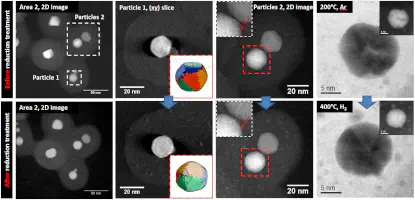Thermal behavior of Pd@SiO 2 nanostructures in various gas environments: a combined 3D and in situ TEM approach

Abstract
The thermal stability of core-shell Pd@SiO2 nanostructures was for the first time directly monitored in the real space by using the in-situ Environmental Transmission Electron Microscopy (E-TEM) at atmospheric pressure coupled with Electron Tomography (ET) realized on the same particles. The core Palladium (Pd) particles, with octahedral or icosahedral shapes, were followed by E-TEM during thermal heating in an H2 and air flow at atmospheric pressure. In a first step, their morphology/faceting evolution was investigated under H2 gas up to 400 °C by E-TEM combined with ET experiments performed on the same particles before and after the in situ treatment. As a result, we observed the formation of new Pd particles inside the silica shell due to the thermally activated diffusion from the core particle, as well as the dependence of the shape and faceting thermal evolution on the initial structure of the particles: the octahedral monocrystalline NPs were found to be less stable than the icosahedral ones, the atom diffusion leads to a decrease of the particles size due to the high atom migration towards the silica shell; the icosahedral polycrystalline NPs do not exhibit morphology/faceting change, the atom diffusion within the particle is favoured against diffusion towards the silica shell, in agreement with a high amount of crystallographic defects. In the second part, the Pd@SiO2 NPs behaviour at high temperatures (up to 1000 °C) was investigated by E-TEM under reductive or oxidative conditions and found to be dependant from the thermal evolution of the silica shell: (1) under H2, the silica is densified and lost its porous structure, the Pd cores remaining thus encapsulated; (2) under air, the silica porosity is maintained and the increase of the temperature leads to an enhancement of the diffusion mechanism from the core towards the external surface of the silica, at 850 °C the totality of the Pd core being thus expulsed outside the silica shell.